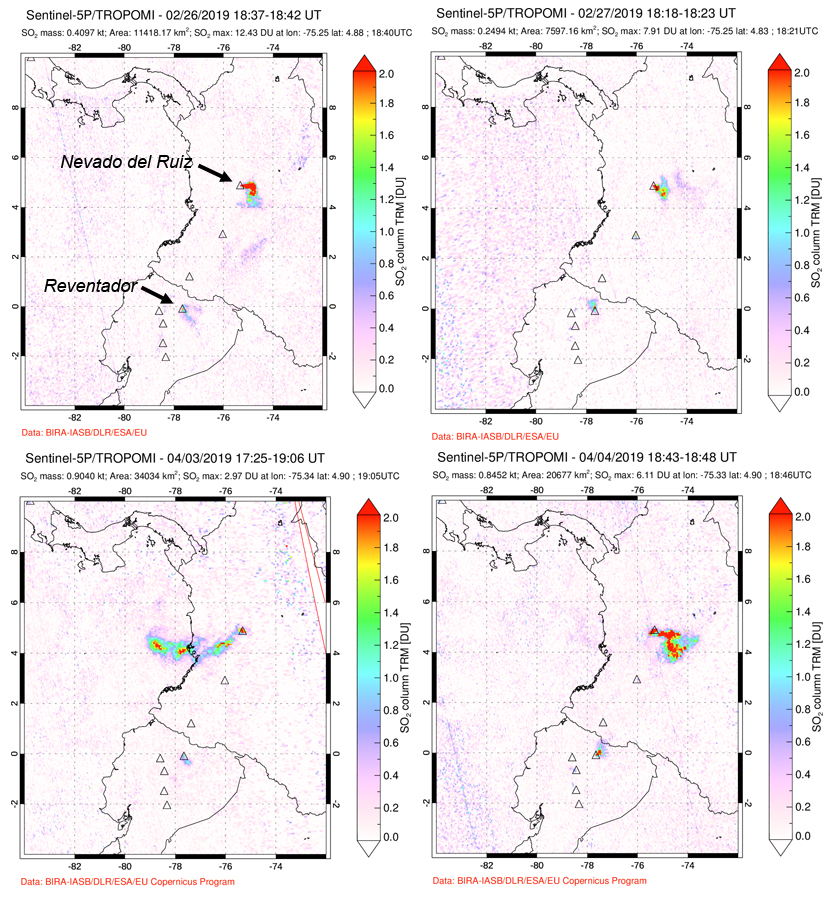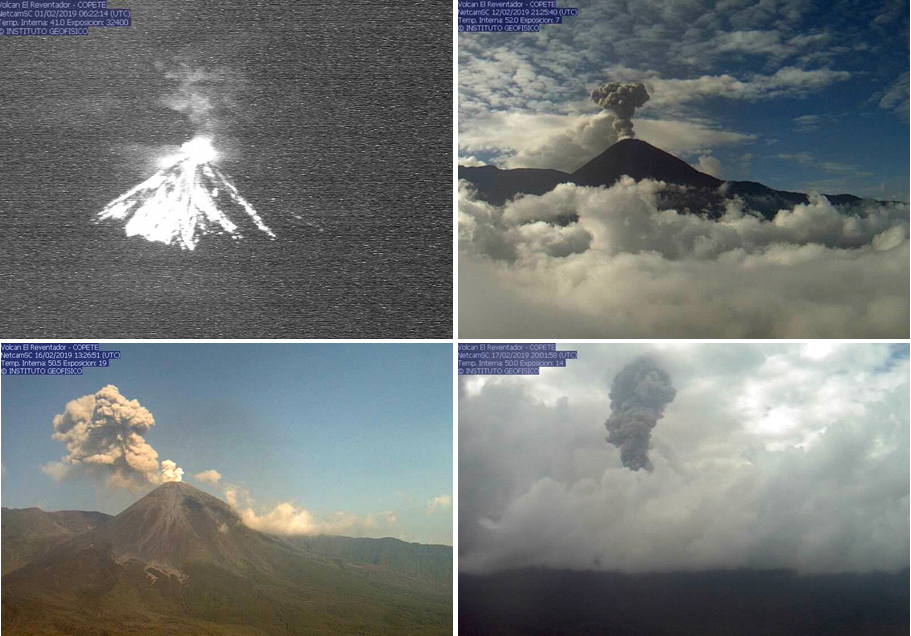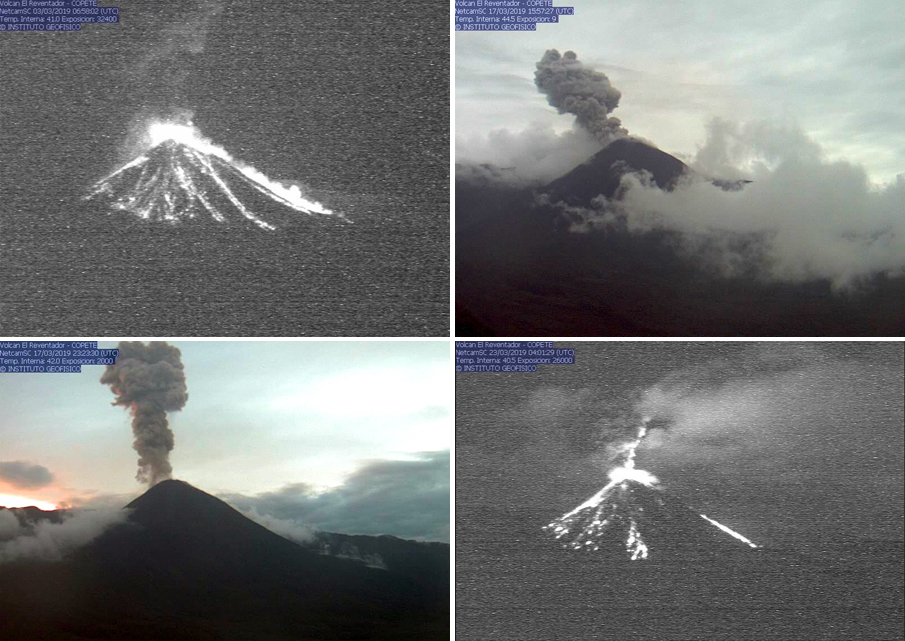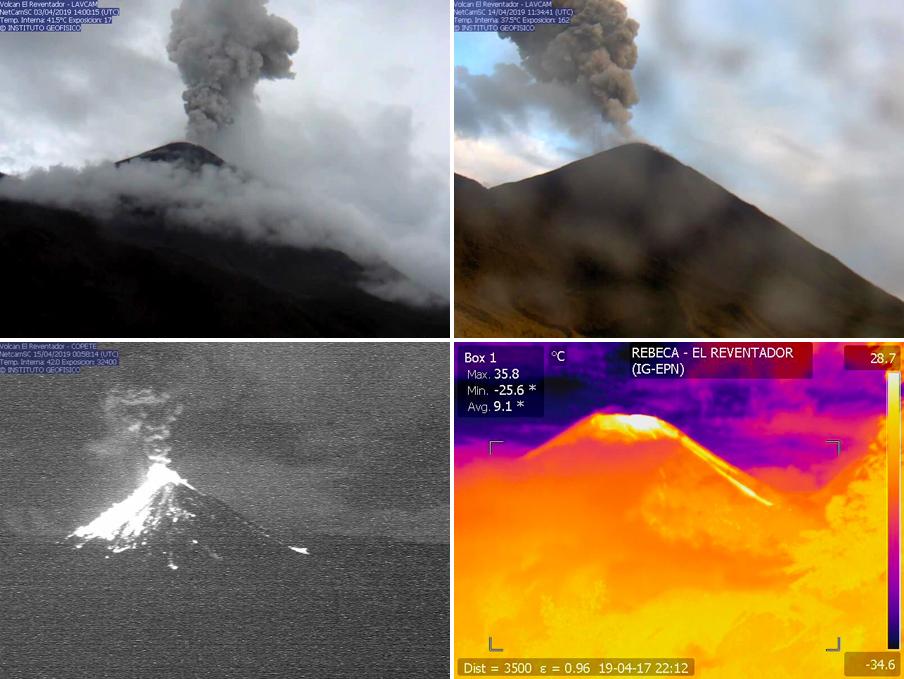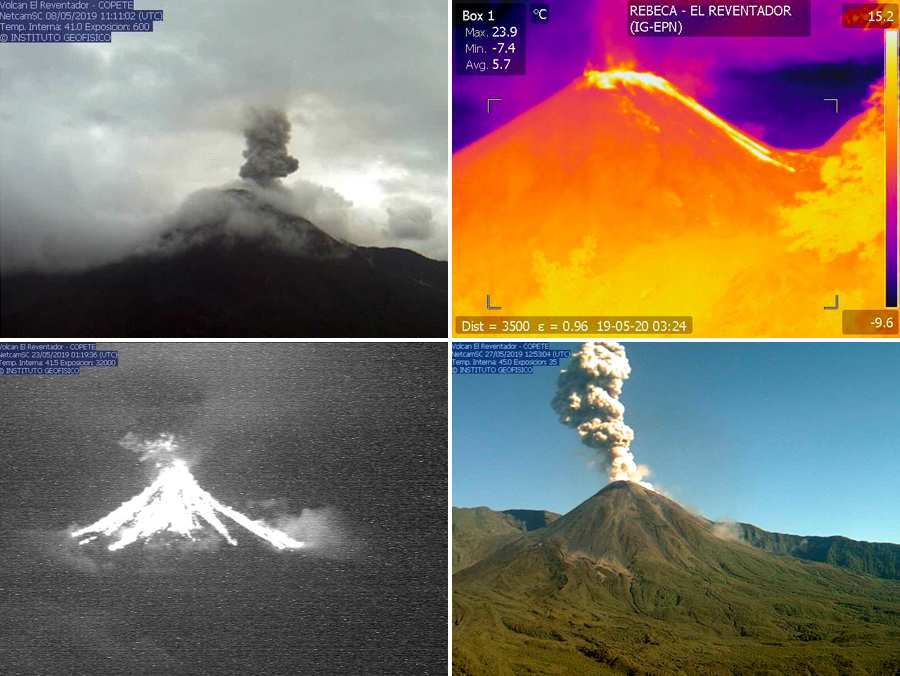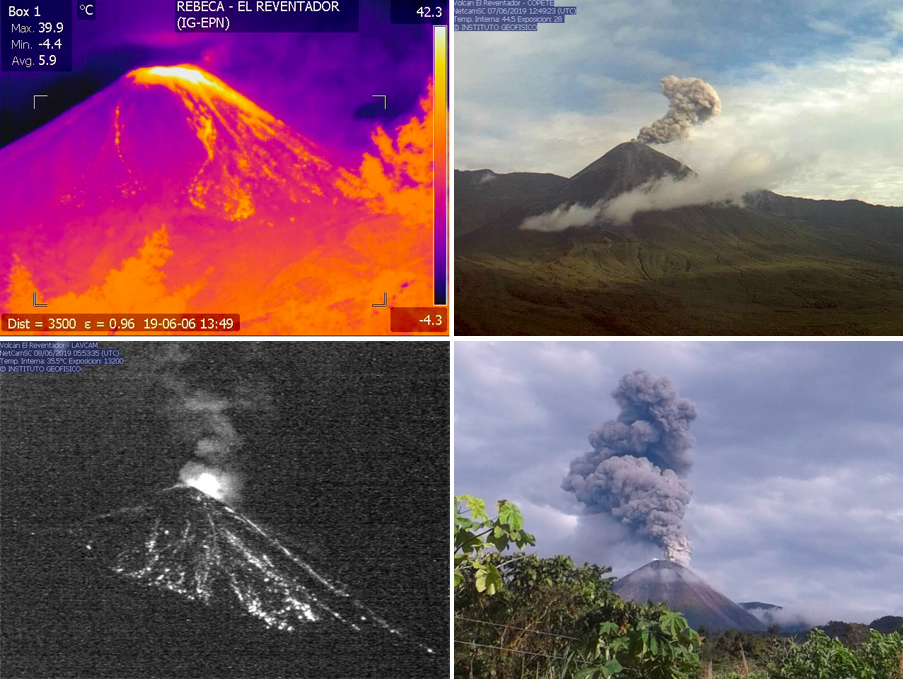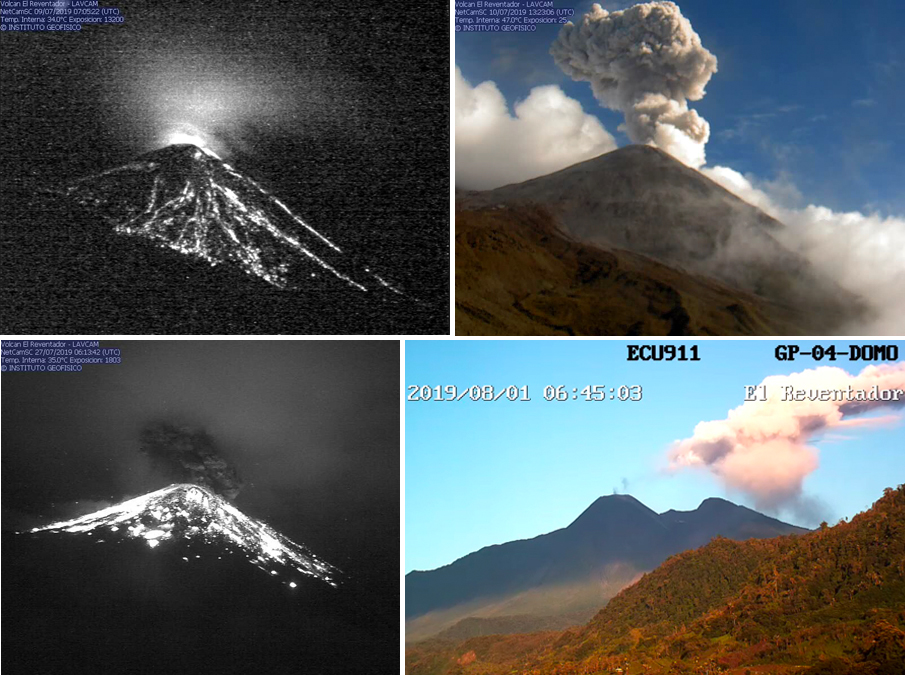Report on Reventador (Ecuador) — August 2019
Bulletin of the Global Volcanism Network, vol. 44, no. 8 (August 2019)
Managing Editor: Edward Venzke.
Edited by A. Elizabeth Crafford.
Reventador (Ecuador) Daily ash emissions and incandescent block avalanches continue, February-July 2019
Please cite this report as:
Global Volcanism Program, 2019. Report on Reventador (Ecuador) (Crafford, A.E., and Venzke, E., eds.). Bulletin of the Global Volcanism Network, 44:8. Smithsonian Institution. https://doi.org/10.5479/si.GVP.BGVN201908-352010
Reventador
Ecuador
0.077°S, 77.656°W; summit elev. 3562 m
All times are local (unless otherwise noted)
The andesitic Volcán El Reventador lies east of the main volcanic axis of the Cordillera Real in Ecuador and has historical eruptions with numerous lava flows and explosive events going back to the 16th century. An eruption in November 2002 generated a 17-km-high eruption cloud, pyroclastic flows that traveled 8 km, and several lava flows. Eruptive activity has been continuous since 2008. Daily explosions with ash emissions and ejecta of incandescent blocks rolling hundreds of meters down the flanks have been typical for many years. Alameida et al. (2019) provide an excellent summary of recent activity (2016-2018) and monitoring. Activity continued during February-July 2019, the period covered in this report, with information provided by Ecuador's Instituto Geofisico (IG-EPN), the Washington Volcano Ash Advisory Center (VAAC), and infrared satellite data.
Persistent thermal activity accompanied daily ash emissions and incandescent block avalanches during February-July 2019 (figure 111). Ash plumes generally rose 600-1,200 m above the summit crater and drifted W or NW; incandescent blocks descended up to 800 m down all the flanks. On 25 February an ash plume reached 9.1 km altitude and drifted SE, causing ashfall in nearby communities. Pyroclastic flows were reported on 18 April and 19 May traveling 500 m down the flanks. Small but distinct SO2 emissions were detectible by satellite instruments a few times during the period (figure 112).
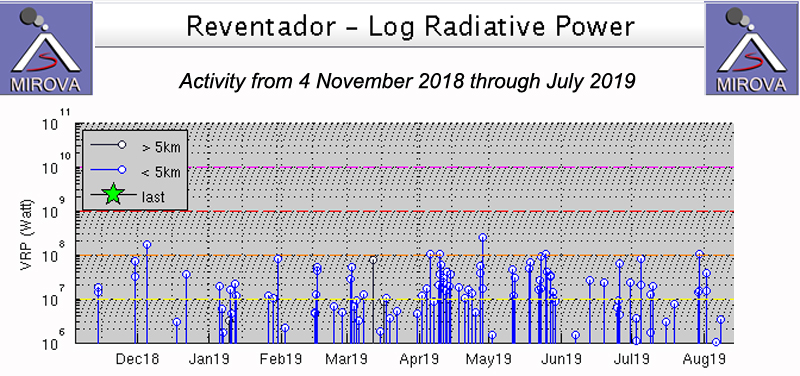 |
Figure 111. The thermal energy at Reventador persisted throughout 4 November 2018 through July 2019, but was highest in April and May. Courtesy of MIROVA. |
The Washington VAAC issued multiple daily ash advisories on all but two days during February 2019. IGEPN reported daily ash emissions rising from 400 to over 1,000 m above the summit crater. Incandescent block avalanches rolled 400-800 m down the flanks on most nights (figure 113). Late on 8 February the Washington VAAC reported an ash plume moving W at 5.8 km altitude extending 10 km from the summit. Plumes rising more than 1,000 m above the summit were reported on 9, 13, 16, 18, 19, and 25 February. On 25 February the Washington VAAC reported an ash plume visible in satellite imagery drifting SE from the summit at 9.1 km altitude that dissipated quickly, and drifted SSE. It was followed by new ash clouds at 7.6 km altitude that drifted S. Ashfall was reported in San Luis in the Parish of Gonzalo Díaz de Pineda by UMEVA Orellana and the Chaco Fire Department.
Ash plumes exceeded 1,000 m in height above the summit almost every day during March 2019 and generally drifted W or NW. The Washington VAAC reported an ash plume visible above the cloud deck at 6.7 km altitude extending 25 km NW early on 3 March; there were no reports of ashfall nearby. Incandescent block avalanches rolled 800 m down all the flanks the previous night; they were visible moving 300-800 m down the flanks most nights throughout the month (figure 114).
During April 2019 ash plume heights ranged from 600 to over 1,000 m above the summit each day, drifting either W or NW. Incandescent avalanche blocks rolled down all the flanks for hundreds of meters daily; the largest explosions sent blocks 800 m from the summit (figure 115). On 18 April IGEPN reported that a pyroclastic flow the previous afternoon had traveled 500 m down the NE flank.
On most days during May 2019, incandescent block avalanches were observed traveling 700-800 m down all the flanks. Ash plume heights ranged from 600 to 1,200 m above the crater each day of the month (figure 116) they were visible. A pyroclastic flow was reported during the afternoon of 19 May that moved 500 m down the N flank.
Activity diminished somewhat during June 2019. Ash plumes reached 1,200 m above the summit early in June but decreased to 600 m or less for the second half of the month. Meteoric clouds prevented observation for most of the third week of June; VAAC reports indicated ash emissions rose to 5.2 km altitude on 19 June and again on 26 June (about 2 km above the crater). Incandescent blocks were reported traveling down all of the flanks, generally 500-800 m, during about half of the days the mountain was visible (figure 117). Multiple VAAC reports were also issued daily during July 2019. Ash plumes were reported by IGEPN rising over 600 m above the crater every day it was visible and incandescent blocks traveled 400-800 m down the flanks (figure 118). The Darwin VAAC reported an ash emission on 9 July that rose to 4.9 km altitude as multiple puffs that drifted W, extending about 35 km from the summit.
References: Almeida M, Gaunt H E, and Ramón P, 2019, Ecuador's El Reventador volcano continually remakes itself, Eos, 100, https://doi.org/10.1029/2019EO117105. Published on 18 March 2019.
Geological Summary. Volcán El Reventador is the most frequently active of a chain of Ecuadorian volcanoes in the Cordillera Real, well east of the principal volcanic axis. The forested, dominantly andesitic stratovolcano has 4-km-wide avalanche scarp open to the E formed by edifice collapse. A young, unvegetated, cone rises from the amphitheater floor to a height comparable to the rim. It has been the source of numerous lava flows as well as explosive eruptions visible from Quito, about 90 km ESE. Frequent lahars in this region of heavy rainfall have left extensive deposits on the scarp slope. The largest recorded eruption took place in 2002, producing a 17-km-high eruption column, pyroclastic flows that traveled up to 8 km, and lava flows from summit and flank vents.
Information Contacts: Instituto Geofísico (IG-EPN), Escuela Politécnica Nacional, Casilla 17-01-2759, Quito, Ecuador (URL: http://www.igepn.edu.ec ); MIROVA (Middle InfraRed Observation of Volcanic Activity), a collaborative project between the Universities of Turin and Florence (Italy) supported by the Centre for Volcanic Risk of the Italian Civil Protection Department (URL: http://www.mirovaweb.it/); Global Sulfur Dioxide Monitoring Page, Atmospheric Chemistry and Dynamics Laboratory, NASA Goddard Space Flight Center (NASA/GSFC), 8800 Greenbelt Road, Goddard, Maryland, USA (URL: https://so2.gsfc.nasa.gov/).


